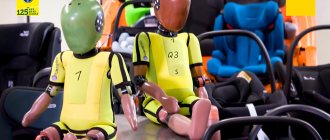The benefits of swimming for a child
Everyone has heard about the benefits of swimming, but what specific benefits will a child receive from visiting such a section? Among the most obvious are:
- uniform development of all muscles of the body. To hold and move through the water, the child coordinates and uses all the muscles of the body, training and strengthening them. The shoulder girdle, arms, legs, and abs develop best;
- strengthening and relaxation of the musculoskeletal system. In water, the body is lighter than on land, all joints and the spine are relieved of compression load and rest. Swimming is recommended for children with slight deviations in posture and various diseases (consultation with a pediatrician is required first);
- fast growth. Reduced compression load on the joints and spine contributes to the rapid growth of skeletal bones;
- improved coordination. To keep the body on the water and swim, the child needs to coordinate body movements, which has a positive effect on the ability to control his body and feel it;
- the functioning of the pulmonary system improves. In order to swim, boys and girls need to learn to breathe correctly, take deep breaths and short exhalations. Constant training of “correct” breathing improves blood saturation with oxygen and helps improve the pulmonary system;
- strengthening the immune system, hardening the body. Water helps strengthen the body's resistance to temperature changes.
- emotional charge, feeling of satisfaction. If a child attending the swimming section gives his all during training, then at the end of the lesson he feels tired, but satisfied.
- removing negativity, reducing nervous tension, irritability. Exercising in water helps relax the nervous system; through active sports, boys and girls release accumulated negative energy and feel more confident.
You can teach a child to swim starting from 2 weeks of age, but most sections begin accepting those interested after 3 years.
The recommended age for starting a swimming class with a coach is 6-7 years old.
Amateur swimming sections provide classes 2-3 times a week for 1 hour. For children under 6 years old, one lesson in water takes about 20 minutes, the remaining time is spent practicing elements on land.
To swim or not to swim: that is the question?
Having fun on the water and swimming make children healthier and strengthen their bodies. Healthy children can swim. In case of illness, you should stop exercising until you recover and get permission from your doctor.
Is swimming good for children?
The benefits of children's swimming are difficult to overestimate:
- Newborns adapt to the world around them faster - coordination of movements improves, crawling and walking skills develop faster, hypo- and hypertonicity of muscles is not observed.
- The respiratory system develops due to the “inclusion” of all parts of the lungs. This is important for children born by cesarean section, with entanglement of the umbilical cord, or with aspiration of amniotic fluid during childbirth. Ventilation of the respiratory system also prevents diseases of the upper respiratory tract.
- Staying in water stabilizes intracranial pressure, improves cerebral circulation, and helps get rid of seizures.
- Stabilization of intrathoracic pressure evens out the functioning of the cardiovascular system.
- Intestinal function improves due to massage with water flows.
- Correct posture is formed, flat feet and scoliosis are prevented.
- Hardening in the form of dousing, rubbing, bathing is an effective way to strengthen a child’s body.
- Children's mood improves, they sleep better and eat better, anxiety and stress disappear, and the nervous system is strengthened.
To achieve the desired result, you need to exercise at least 2 times a week.
7 reasons when swimming is prohibited
- during exacerbation of any disease;
- in case of serious developmental disorders (individually);
- at risk of developing seizures;
- at elevated body temperature;
- with open wounds;
- for skin infections;
- for heart failure.
The load is reduced
- with low weight;
- with a tendency to colds.
Class is terminated
- when crying;
- with a bluish nasolabial triangle;
- when trembling and goose bumps appear.
If your baby is cold, you should try to warm him up by adding hot water, holding him close or rubbing him with a towel.
Children with serious health problems (rickets, anemia, central nervous system diseases, malnutrition) can swim, but in this case the exercises are of a medical nature. A specialist allows them access, and he also determines a detailed lesson plan.
Swimming for children of different ages
Depending on the age of the child, different techniques and methods of teaching children are used.
From 2 weeks to 3 years, the baby is trained in infant swimming techniques based on the development of innate reflexes: swimming and holding the breath. If you want to teach a child of this age, it is advisable to undergo instruction or study under the guidance of a specialist. Children are allowed in the pool from 2 months
From 3 to 6 years old, techniques are used to teach the basics of swimming: understanding the properties of water, its resistance to body movements, ways to hold the body on the water in a horizontal position and a vertical position. As a result, by the age of 6 the child learns to lie on his back in the water.
Up to 5-6 years of age, parents must be present during classes. When sending a preschooler to the swimming section, you should take into account that for him it will be more entertainment than targeted training. A conscious attitude towards activities appears in children closer to 6 years of age. Most often, children from 3 to 6 years old are taught individually or in small groups (up to 5 people).
From 6-7 years old, teaching techniques for different swimming styles (breaststroke, crawl) are used. If a child is just starting to go swimming, then in the first months he will be taught to hold his body on the water, correctly coordinate the movements of his arms and legs, and relax. Younger schoolchildren are more collected than preschoolers; they can hold attention to the coach’s explanations longer and clearly complete assigned tasks.
Classes in the swimming section for preschool children are always carried out according to a general health program, the main goal is to teach how to behave in water and improve physical performance. Professional swimming training begins after the age of 7, if the child shows good results and has the ability for this sport.
The dangers of swimming in the pool during infancy
Due to the increased popularity of infant swimming, scientists have also shown interest in this phenomenon. Recent studies conducted in Europe have shown that playing at such a young age in public swimming pools causes harm to the respiratory system. This is due to the high concentration of water and the addition of chlorine to it. Chemical elements can cause allergic reactions in children and provoke the development of asthma and other chronic diseases.
In addition, bleach is also harmful to children’s delicate skin. It dries it out and makes it more susceptible to the environment. In special cases, contact with chlorinated water may cause bright red spots, similar to minor burns, to form on the body of infants.
Thus, swimming in public pools can indeed be dangerous for the baby due to the chlorine content in the water, but nowadays there are also swimming centers where disinfection is carried out using other means. So sensitive parents can always find an alternative.
How does swimming training work?
Methods and techniques for teaching swimming depend on the goal that parents pursue when sending their child to the section:
- if the main goal is to improve the child’s health, harmonious development and formation of motor skills, then it is enough to attend the section 2-3 times a week and work with a coach to develop the fundamentals of swimming.
- When aiming for athletic achievements, in addition to daily training, there should be classes to develop skills on land, building muscle strength on the treadmill and in the gym.
A child can get into professional swimming only after attending a recreational swimming training group, after assessing the abilities and recommendations of the coach.
A visit to the swimming section should bring pleasure and joy to the child, only in this case it will be possible to achieve good results and not harm the child’s health.
Before starting to teach a child to swim, the coach must do some preparatory work. First of all, the baby must learn to lie on the water, feel how to control his body in new conditions.
After the child masters the ability to lie on the water, he will be taught to glide on it. In most cases, special boards are used for this. Leaning on it, the child pushes off from the bottom of the pool and begins to intensively move his feet in the water. This way he learns to move in water.
Along with the ability to hold their body and slide, the coach teaches children to breathe correctly. In order for the body to be well retained by water, a person's lungs must have enough air. Proper breathing is the key to successful swimming.
Only after fully mastering the ability to hold the body on the water and glide, as well as breathe correctly, the coach begins to teach the child different swimming styles.
Teaching children in the swimming section differs from teaching adults in its approaches. If an adult wants to learn to swim, then the coach first of all works to reduce fear of water. Children's learning is structured differently. The goal of the coach is to teach how to act correctly in the water, how to feel your body, not to be afraid of water, but not to become careless.
The technique of teaching children to swim requires mandatory practice of all elements on the shore before using it in the water. Be sure to tell your baby about this feature, ask him to be attentive to the words of the trainer, try to learn all the nuances of the movements before practicing them in the water. This will ensure quick learning and pleasure from visiting the section.
Benefits and harm to the body
Pediatricians note that swimming has a positive effect on the health of children. There are many advantages:
- Immunity is strengthened. The body gets used to temperature changes.
- During swimming, spasms are relieved - this is not always achieved even with the help of massage.
- Breathing improves.
- Beautiful posture is formed.
- Coordination and flexibility develop.
- After playing sports, the appetite improves and the child gains weight faster.
- Procedures in water have a positive effect on the nervous system. Children who attended swimming lessons for little ones are less likely than their peers to worry and feel fear.
Babies who go to the infant pool early get sick much less often than their peers and sleep better at night. Infant swimming is essentially gymnastics, only in unusual conditions. To perform the exercises, the child has to overcome the resistance of the water. During training, the sweat glands are cleansed and blood circulation is activated. Unusual activities not only improve health, but also perfectly lift the baby’s mood.
One of the main advantages of this sport is that you can practice it at any time of the year. The swimming pools are open today for children of all ages. In some, classes are held for infants; it will also not be difficult to find a pool for children from 2 years old, and advanced swimming lessons for children from 3 years old.
At what age should you start early swimming in the pool?
In the mother's tummy, the baby is in an aquatic environment. After birth, he already knows how to hold his breath and even swim. This skill disappears by about 4 months if you do not purposefully develop it. That is why many pediatricians believe that the sooner after birth you start classes, the better. If the moment is missed, then it is better to start training much later - from 4 years old or even from 5 years old. This is already the age at which the child begins to carry out the coach’s commands consciously. However, other experts are of the opinion that classes from 2 years old will also be effective and will help the baby quickly adapt to the aquatic environment.
Before starting classes, you need to make an appointment with a pediatrician, orthopedist and neurologist. There are not many contraindications, however, they exist. These include:
- ARVI and pneumonia;
- Congenital heart defect;
- neurological pathology with convulsive syndrome;
- dislocations;
- osteomyelitis of the extremities;
- allergic reactions;
- staphylococcal infection;
- renal or liver failure.
Pool exercises are recommended for malnutrition, anemia, rickets, and minor problems with the musculoskeletal system. Water training is suitable for children with serious illnesses - for example, with PEP and cerebral palsy.
Medical contraindications
Before you start visiting the swimming section, you will definitely need to visit your local pediatrician. A child may be refused a certificate if he or she has contraindications:
- heart disease;
- convulsive syndrome;
- skin disease with a violation of the integrity of the skin (eczema);
- infectious skin diseases (scabies);
- epilepsy;
- obvious signs of a viral infection: runny nose, fever, cough.
The main advantages of swimming
Swimming has a positive effect on a child's body, since absolutely all the muscles of the body are involved during exercise. Water procedures can improve the functioning of many organs and systems and are an excellent prevention of problems with the spine and musculoskeletal system. The benefits of swimming in the pool are especially noticeable for children of preschool and school age. Since it is during this period that the entire organism of a small person actively develops. Answering the question about the benefits of swimming in a pool for children, we can highlight the following advantages of this activity:
- activation of metabolic processes;
- strengthening the respiratory tract;
- toning the heart muscle and the entire circulatory system as a whole;
- maintaining correct posture;
- prevention of flat feet;
- saturating the baby's skin with microelements through natural water massage.
In addition, regular swimming lessons help develop a healthy and developed personality in a child. Scientists have proven that water exercises contribute to the development of such traits as determination, determination, courage, independence, and sociability. Swimming also improves the child’s appetite, promotes deeper sleep, relieves emotional stress, and brings pleasure and joy to the baby.
Equipment required for classes
For the first lessons in the swimming section you need to prepare:
- swimming trunks;
- swimming cap;
- rubber slippers or other shoes for walking from the locker room to the pool;
- Goggles;
- washcloth and soap;
- towel;
- cotton hat She gets dressed after a post-workout shower until her hair is completely dry;
Depending on the number of children in the group, sleeves, a collar or a belt may be needed. The need to purchase these parts must be clarified with the trainer.
What's the best way to start exercising?
In order for infant swimming to become a part of your family’s life for a long time, the mother can first undergo special training from an instructor with a medical education, and then practice with the baby at home. During classes, it is important to follow safety precautions and be extremely careful.
First, prepare everything you need for swimming. Pre-wash the bathtub with laundry soap. It is not recommended to use powders and products with aggressive compositions - the child may develop allergies. Nothing is required for disinfection. The water should be from 34° to 36°C initially, then it can be gradually lowered to 29°C. The temperature in the pool is at least 30°C. The duration of the first procedures is no more than 10 minutes.
If a baby cries non-stop, then this behavior should alert parents - it may indicate that the water is too cold or hot. Excessive passivity is also alarming - if the baby is lethargic and wants to sleep, then most likely the bath is too warm for him.
Swimming for infants can be done both in the morning and in the evening. It all depends on your daily routine and your child's preferences. However, for those kids who are easily excited and slow to calm down, it is better to study in the first half of the day. The main rule is that at least one and a half hours should pass after feeding.
How to teach a child to swim at home: step-by-step instructions
The child must be in a good mood. It is important that breast milk is already well digested, but that the feeling of hunger has not yet set in.
Gently lower the child into the prepared bath and wait a little to understand what sensations he experiences. If you hear crying, do not rush to get the baby out right away; it is better to give him time to get comfortable. When your baby calms down, begin the following exercises:
- Lay the baby horizontally on his back. Gently secure it with your palm from below. As a result, the baby should practically lie on the water independently, and the mother should only slightly support the head.
- Turn your baby over so that he is tummy down this time. The whole body should be immersed in water, except for the head - its mother supports it by the chin. Try teaching your baby to splash. Repeat this exercise during every bath, and then soon the child will be able to row.
- Lower the child horizontally with his back down. It is important that his legs are located near the side. Swimming for children from a support allows them to push off from a solid surface and swim a little on their own. This exercise is recommended to be done when the baby already feels confident in the water.
- Place a rubber toy in the water a short distance from the baby so that he tries to get to it on his own. Gradually increase the path to the goal.
- When the baby can confidently float on his own, you can move on to diving. Submerge it completely for a few seconds. Repeat the exercise no more than five times.
What to do if your child refuses to go swimming
The benefits of swimming for children are undeniable, but often enough when faced with difficulties during training, children begin to refuse to attend the section. In this situation, parents need to assess the situation according to several criteria:
Ask your child about the reasons for not wanting to attend the selected section.
Depending on the child’s answer, there are several options:
- I don't like the coach and his teaching style. In such a situation, you need to clarify what exactly the child does not like about the coach. Perhaps the section leader demands too much from the child or does not explain it clearly enough. In this situation, you can go up and talk directly with the coach about his view of the current situation, if after that the situation does not change, you can find another specialist.
- Difficulty performing the proposed load. Talk to the trainer, ask that the training program be revised for the time being for your baby.
- Misunderstanding with the guys in the group. In children's groups, sometimes there are clashes and ridicule; if your baby refuses to go because of difficulties in communicating with other children, talk to the coach so that he can use pedagogical technologies and talk with the parents of other children.
In any case, before refusing to visit the pool, you need to talk with the coach, find out his opinion about your child’s abilities and capabilities, and hear his professional opinion about the current situation. Children, especially younger schoolchildren, cannot always clearly explain the reason for their reluctance to attend the section. If you do not find the reason for this reluctance, then there is a possibility that the same problems will appear in another circle or section. The first step to regaining the desire to take extra classes is to find the reason for the rejection.
Offer to try another sport
Swimming is a good form of exercise, but not all children enjoy going to the pool. Each baby is individual, and perhaps another sport will be more desirable for your baby. This option is suitable for you if the child, being on good terms with the coach and children, performs all the proposed loads easily, does not feel the desire to go to training, and enthusiastically talks about other activities.
How are lessons with kids in the pool?
Babies get tired quickly, so the first lessons should not be too long - for a child under three months old, 10 minutes is enough. By six months, the duration of babies’ bathing in the pool should increase to 20–30 minutes. At an older age, the maximum time spent in the pool is limited only by the child’s desires. Here are the basic rules of infant swimming:
- During the first lessons, hold your child so that he can see your face. Making eye contact and smiling will reassure him that everything is okay and help him relax.
- Enter the water with your baby, holding him in a “cradle” position. Talk to him constantly so that he is not afraid.
- Move the child away from you a little, supporting him with your hands under his back; the rest of the body will be supported by the water. After some time, the baby will begin to move its arms and legs. Babies in the first months of life can only be bathed on their backs, but at the age when they master crawling, they often begin to enjoy “swimming” on their stomachs. In this case, the mother should support the baby with one hand under the tummy and with the other under the chin.
- Let your baby get used to the feeling of water on his face by wetting his face. At home in the bath, you can use a sponge or watering can for this; during swimming lessons for babies in the pool, simply dip your hand in the water and raise it above the child’s head so that the drops flow onto the face.
- Lower your baby's head slightly so that his ears are under the water. For the first time, hold it like this for just a couple of seconds; during subsequent baths, you can gradually increase the time. At first, the child will be a little worried because all the sounds suddenly become muffled. However, this is a necessary exercise to achieve the next level - full immersion.
- When bathing babies in the pool, it is important to take into account that their thermoregulation is still imperfect. A child in the first months of life can quickly freeze, so move more, periodically lift the baby and lower it into the water again.
- Play with him so that visits to the pool become a welcome entertainment for him. Little older children usually really like it when they are supported under the arms and can hit the water with their palms. Many children are delighted to be placed on the side of the pool and then returned to the water. Another fun activity is to blow bubbles with your mouth together with your mother.
- Gradually improve your child’s skills, trying to ensure that water becomes his native element. Keep in mind that kids are conservatives and usually perceive changes without enthusiasm. To ensure that your baby treats them calmly, constantly talk to him and sing songs. You can also hide learning new skills inside your favorite water games. For example, if your child likes it when you lift him above your head and then return him to the water, at one point you plunge him headlong - most likely, the baby will not even notice that anything unusual has happened.
During your first lessons, it is advisable for you to seek the services of an infant swimming coach. Standing in the water nearby, he will tell you what to do. When you have mastered all the intricacies, you can work with your baby on your own.
How to keep swimming safe?
The above disadvantages look quite impressive, and may discourage parents from sending their child to swimming. However, risks can be minimized. How to do it? Choose your swimming pool carefully. New methods have been invented to purify water other than adding chlorine alone, in particular combined treatment with ozone and chlorine. First, the water is purified with ozone, then a safe dose of chlorine is added to it. Choose pools with this method of water purification.
Disinfection using ultraviolet light has now become fashionable, but experts advise avoiding pools where the water is purified in this way. There is a high probability that the bacteria are not completely killed and continue to actively multiply under the influence of artificial sun. In some pools, copper and silver ions are used to disinfect water, but this method gives a good effect only if the volume of the reservoir is small. To treat a tank of impressive size, round-the-clock disinfection will be necessary, and this will be too expensive for the organization.
Pay attention to the condition of the sides, stairs, benches. If these items visually look dirty, it is better to avoid visiting this pool. Come to class in the morning when the water is clearest. It is better to avoid visiting pools in the evenings, since you will have to swim in water contaminated during the day by other bathers. Teach your child important hygiene procedures to ensure that they enter the water as clean as possible, because the less organic material that gets into the water, the less chloramines will appear. In the summer, move swimming lessons to open waters, go to rivers and lakes. Teach your child to wash thoroughly after each shower session to remove all chlorine. Choose high-quality hair caps, establish good nutrition, and use baby nourishing cream.
How much do classes cost?
Synchronized swimming classes will not require large financial expenditures from parents. In Olympic reserve schools or other budget sections, classes are usually free or inexpensive: 100-500 rubles per month. If you choose a section in a fitness club or a private synchronized swimming school, you will have to spend money. Classes will cost at least 500 rubles per month. In this case, you need to pay all field fees and competitions. In public schools, only a portion of these costs are borne by parents.
In any case, you must buy the equipment yourself. The girl will need:
- Swimsuit for training. Please note: it should fit snugly to the body, but not rub. The cost of a swimsuit in sports stores starts from 500 rubles.
- Swimsuit for competitions. The cost varies from 650 to 5000 rubles.
- Swimming cap. You must purchase at least two: for training and for performances. On average they cost 300-500 rubles.
- Nose clips. A set of clips and earplugs costs 100-700 rubles.
- Swimming goggles: 200-700 rubles.
Thus, you will spend at least 2000 rubles on equipment. It needs to be updated as the child grows, on average once a year.











